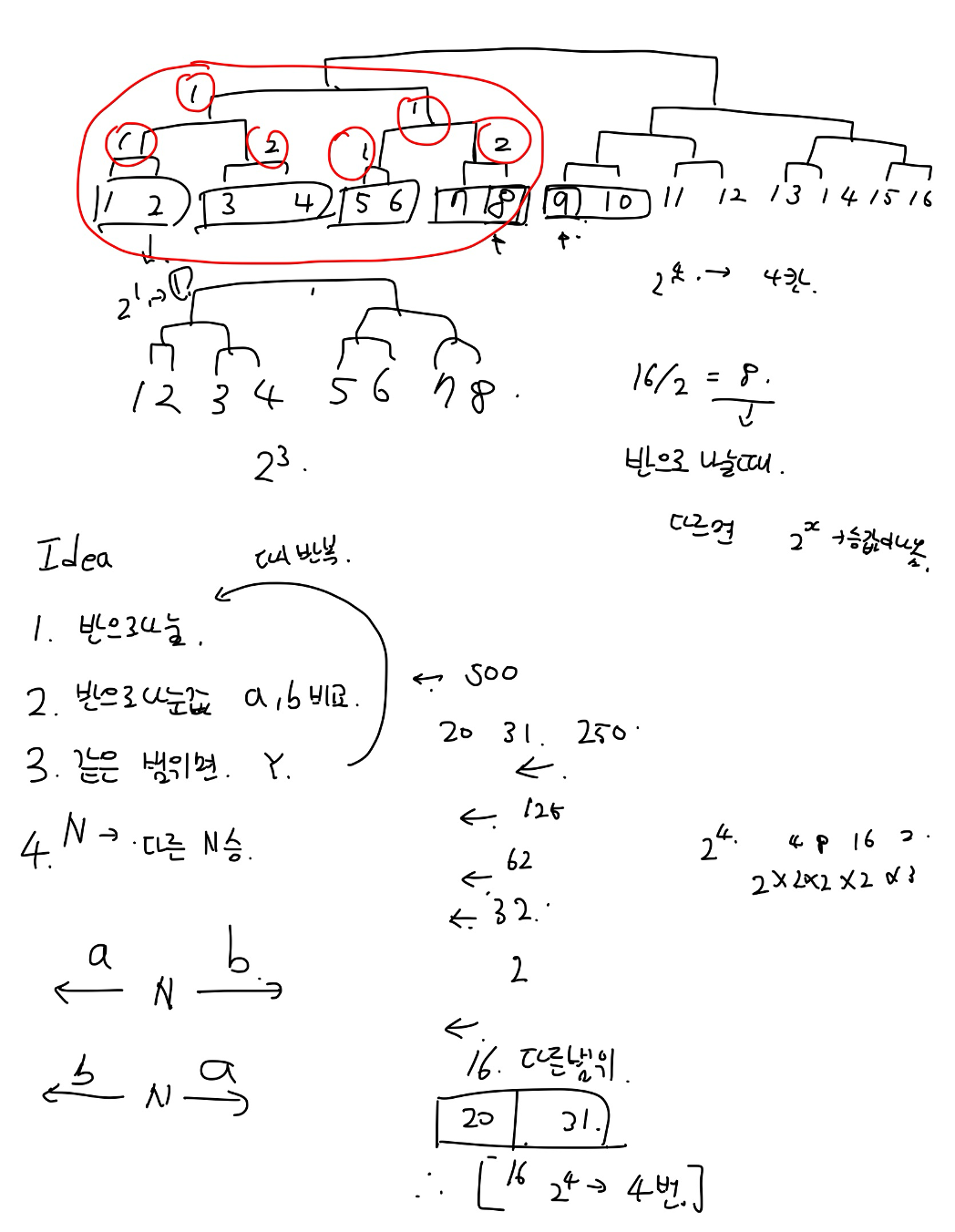부르트포스 풀이법으로 접근하였으나
30분이상 고민해보고 풀어봤음에도 감을 잡지 못하여 다른 풀이를 참고하여 도움을 받았습니다.
제가 했던 접근방식은 어렵게 접근하였고 문제를 약간 무시하다 싶은 정도의 낮은 이해력으로
풀지 못한 것 같습니다.
다시 한번 문제를 깊이 있게 이해하여 푸는 것이 중요한 것 같습니다.
풀이 접근 보여드리겠습니다.

빨강 강조 부분을 보면 확실하게 문제를 잘못 이해 한것을 볼수 있습니다.
아래 풀이가 올바른 접근 법이였습니다.

이렇게 접근하면 더 쉬운 풀이가 보입니다.
아래는 제가 풀어본 코드이며 다 오답이고 가장 아래 풀이가 정답입니다
package Question;
import java.io.*;
import java.util.Scanner;
// 백준 토너먼트
// https://www.acmicpc.net/problem/1057
public class Tournament {
public static void main(String[] args) throws IOException {
System.out.println(solution(16,1,2));
System.out.println(solution(16,8,9));
System.out.println(solution(1000,20,31));
System.out.println(solution(65536,1000,35000));
System.out.println(solution(60000,101,891));
System.out.println(solution(7801,200,711));
solutionBack();
solution();
}
// 부르트 포스 접근법
/**
* IDEA
* 1. n 을 반으로 나눈다.
* 2. a와 b 를 n 과 비교한다. (나눈 나온 결과 값 x , 1 부터 n 이면 a 는 x 과 같은지 까지 비교, b는 x 초과 값 부터 n 의 마지막)
* 3. 만약 a와 b같은 범위라면 1번부터 다시 시작
* 4. 만약 둘의 범위 가 반으로 나뉘었을때 다르다면 나누고 나온 최대값의 2의 n승값이 그 결과임
*
* 2의 제곱근 n 을 구한다고 생각하면 됨 만약
* 2의 제곱근의 값이 아니라면 2로 나눈후 남은 값을 빼고 진행하면 됨
*
* */
public static int solution(int n, int a, int b) {
int answer = -1;
int exponent = -1;
while (true){
n = Math.round((float) n /2);
//System.out.println(n + " t");
// 범위 체크
// 걸리면 n 승 구하기
if(b <= n && n <= a){
exponent = (int) Math.ceil((Math.log(n*2) / Math.log(2)));
break;
} else if ( a <= n && n <= b) {
exponent = (int) Math.ceil((Math.log(n*2) / Math.log(2)));
break;
} else if (a >= n && b >= n) {
exponent = (int) Math.ceil((Math.log(n) / Math.log(2)));
break;
}
if(n == 1) break;
}
answer = exponent;
return answer;
}
// 백준 입력 방식
public static void solutionBack() throws IOException {
int answer = -1;
Scanner sc = new Scanner(System.in);
int n = sc.nextInt();
int a = sc.nextInt();
int b = sc.nextInt();
//System.out.println((Math.log(468) / Math.log(2)) + "dd");
int exponent = -1;
while (true){
n = Math.round((float) n /2);
//System.out.println(n + " t");
// 범위 체크
// 걸리면 n 승 구하기
if(b <= n && n <= a){
exponent = (int) Math.ceil((Math.log(n*2) / Math.log(2)));
break;
} else if ( a <= n && n <= b) {
exponent = (int) Math.ceil((Math.log(n*2) / Math.log(2)));
break;
} else if (a >= n && b >= n) {
exponent = (int) Math.ceil((Math.log(n) / Math.log(2)));
break;
}
if(n == 1) break;
}
answer = exponent;
System.out.println(answer);
}
// 해설지의 도움을 받음
// 문제의 이해력 부족...
// 시간을 더 들였으면 풀었을 것 같으나 많은 시간이 걸렸을 것 같음
public static void solution(){
Scanner sc = new Scanner(System.in);
int n=sc.nextInt();
int zimin =sc.nextInt();
int hansu =sc.nextInt();
int count = 0;
while(zimin != hansu) {
zimin = zimin/2 + zimin%2;
hansu = hansu/2 + hansu%2;
count++;
}
System.out.println(count);
}
}